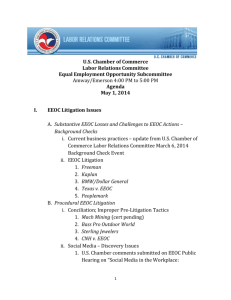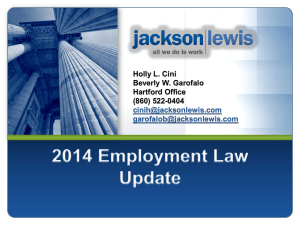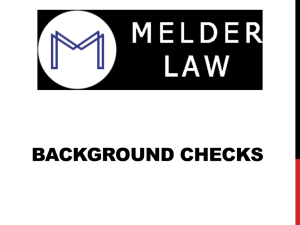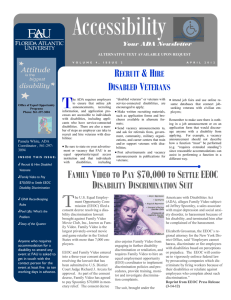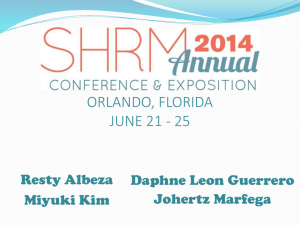EEOC v. Cognis - VG Young Institute of County Government
advertisement
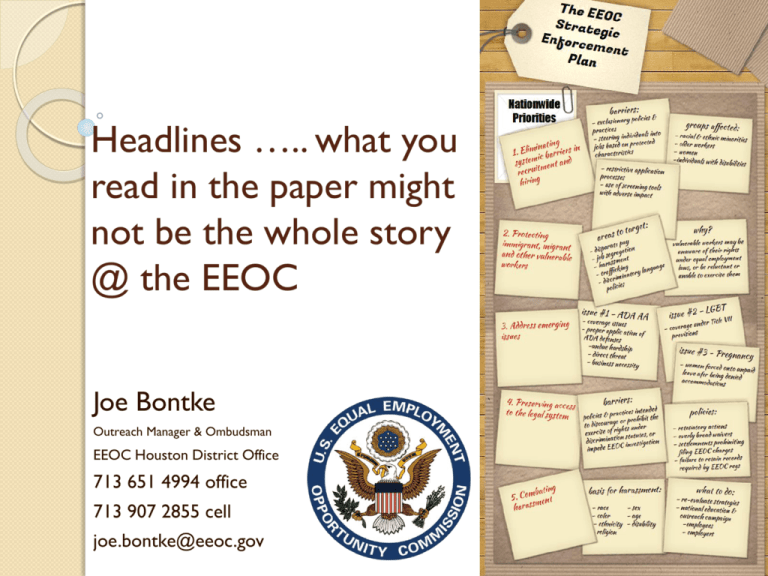
Headlines ….. what you read in the paper might not be the whole story @ the EEOC Joe Bontke Outreach Manager & Ombudsman EEOC Houston District Office 713 651 4994 office 713 907 2855 cell joe.bontke@eeoc.gov I know you’re thinking …. where have I seen him before? Protected Federal Categories Race National Origin Color color Genetic Information Religion Disability Sex Age 40+ EEOC Cases Filed By All Discrimination Types – FY 2014 What’s in your “backpack” It’s what we “bring” to work It’s who I am It’s my “stuff” The box made it look so very easy The 136 page instructions said it would take “three people two hours” 1 Happy Granddaughter Obligations of Employers - Make the workplace free of unlawful discrimination, harassment and retaliation - Promptly and confidentially investigate complaints of discrimination, harassment and retaliation - Where discrimination, harassment and retaliation may have occurred, take prompt and appropriate remedial action (i.e., discipline commensurate with the offense) Equal Employment Opportunity Commission Yesterday 10,000 9,000 8,000 7,000 6,000 5,000 4,000 3,000 2,000 1,000 0 vs Today 120,000 100,000 99,922 95,402 93,277 FY 08 FY 09 FY 10 Fiscal Year 99,947 99,412 93,727 82,792 Actual Charges Projected 80,000 75,768 60,000 40,000 20,000 0 FY 06 Charge Receipts FY 07 FY 11 FY 12 FY 13 Survey Question: Over the past 12 months, has your company focused more effort on retaliation prevention? A. Yes B. No C. I’m not sure Top EEO Risk Area ‐ Retaliation EEOC Charge Stats: 37,955 retaliation charges received in 2014, forming 42.8% of all charges. For 4th year running, the #1 most common basis for an EEO charge! The underlying claim of harassment or discrimination doesn’t need to be proved. Most managers and supervisors don’t understand retaliation risks! SEP National Priorities 1. Eliminate barriers in recruitment and hiring 2. Protect immigrant, migrant and other vulnerable workers 3. Address emerging and developing employment discrimination issues 4. Enforce equal pay laws 5. Preserve access to the legal system 6. Prevent harassment through systemic enforcement and targeted outreach Headlines & the truth Plan of Attack? Enforcement Raids? Strategic Enforcement Plan Overview National + Local Priorities = Impact http://www.eeoc.gov/eeoc/plan/sep.cfm Adopted December 2012 Purpose: To focus and coordinate EEOC programs to have a sustainable impact in reducing/ deterring discrimination Six national priorities Integrated enforcement approach District plans Discretion to investigate and litigate non-SEP issues Enforcement Focused on Priorities Strategic enforcement leads to greater impact thru focused attention on priorities and allocation of resources Prioritization means focus, not disregard for other issues. Continued Enforcement on other issues where government action has impact ENFORCEMENT PRIORITY NO. 1: Hiring and Recruitment. Priority to Criminals? Hire Bad Employees? Forced Hiring of Convicts? Criminal Background Checks • Why is the Commission interested in this? – Using blanket policies may adversely impact certain protected groups – Reports contain errors – http://www.eeoc.gov/laws/guidance/arrest_ conviction.cfm • Disparate Treatment • Adverse Impact: Criminal Background Checks • Must show “job relatedness” and “consistent with business necessity” (Green v Missouri Pacific Railroad) • Some level of risk is inevitable in all hiring. It’s ultimately about risk management • Must accurately distinguish between those applicants who pose an unacceptable risk and those who do not (be careful of blanket exclusions) Criminal Background Checks Two circumstances where employers will meet “job relatedness” and “consistent with business necessity” – The employer validates the criminal conduct screen for the position in question – The employer is considering at least: • the nature of the crime, • the time elapsed, and • the nature of the job , Eliminating Barriers in Recruitment/Hiring • • • • Exclusionary Policies & Practices Restrictive Application Processes Restrictive Screening Tools Steering Particular Groups into Specific Job Types Background Screening Cases – Recent Resolutions EEOC v. Pepsi (2012) (conciliation) • $3,130,000 to more than 300 African Americans adversely affected by background screening policy EEOC v. Kaplan Higher Ed., 732 F.3d 584 (6th Cir. 2013) • Affirmed dismissal of EEOC case based on exclusion of expert testimony EEOC v. Freeman, 961 F.Supp.2d 783 (D.Md. 2013) • Granted summary judgment to employer in challenge to background and credit history checks alleged to have a discriminatory impact on African-American and male applicants • On appeal to 4th Circuit REFERENCE CHECKING HAVE YOU EVER HAD A “BAD HIRE”? What is truth? Finished files are the result of years of scientific study combined with the experince of many years of experts. Finished files are the result of years of scientific study combined with the experince of many years of experts. Is your perception …. Sometimes your truth? • Sometimes we have to take another look at what we think we know Immigrant, Migrant and Other Vulnerable Workers Immigrant, Migrant and Other Vulnerable Workers • • • • Disparate Pay Job Segregation Harassment Trafficking • Vulnerable workers are those who are unaware of their rights or reluctant or unable to exercise them • Individuals with intellectual disabilities • Youth in their first jobs Immigrant, Migrant and Other Vulnerable Workers: Selected EEOC Cases EEOC v. Global Horizons (D. Hawaii 2011) District Court ruled in favor of EEOC in March 2014 – finding unlawful harassment, discrimination and retaliation against hundreds of Thai workers in the US Alleges physical abuse, exploitation, and barbaric security measures Trial to determine damages set for November 5 farms settled claims for $$ and accountability measures Washington case set for trial on Sept. 15; District Court granted judgment to 2 growers and dismissed claims against them (2014 WL 2207866 E.D.Wash. 2014). EEOC v. Signal Int’l (S.D. Miss. filed Apr. 2011) Alleges 500+ Indian employees subjected to labor trafficking and hostile work environment EEOC v. Henry’s Turkey Service (W.D. Iowa 2013) http://www.nytimes.com/interactive/2014/03/09/us/100000002755950.app.html?_r=0 EEOC v. Henry’s Turkey Service • $240,000,000 jury verdict in favor of EEOC for 32 intellectually disabled men • Highest verdict in the history of the EEOC; second highest in U.S. history under federal anti-discrimination laws • Court granted summary judgment in favor of EEOC on its wage discrimination claims in the amount of $1,300,000 • $7,500,000 each to 32 disabled victims ($2,000,000 in punitive damages and $5,500,000 in compensatory damages) • Verdict reduced to $1,600,000 (0.67 of jury verdict per person) Veterans: Employment – As of 2011, there were 21.6 million veterans in the U.S. – 2.4 million veterans have served during the Gulf War II period. 17% of these veterans are women. – As of the end of Fiscal Year 2011, Gulf War II veterans are experiencing significant unemployment rates: Example: 18-24 year old male Gulf War II vets: 29% (non-vet males of same age: 17%) – Unemployment rates for veterans generally – about 8% Veterans: Disabilities • Gulf War Veterans are more likely to report a serviceconnected disability than other veterans (26% versus 14% for all veterans) About 3 million veterans have serviceconnected disabilities. • Unemployment rates for all veterans – those with disabilities and those without – are about the same – about 8%. • Unemployment rates for Gulf War II veterans with and without disabilities are about the same – about 12%. Post-Traumatic Stress Disorder & Traumatic Brain Injury • Approximately 5000 combat deaths Iraq and Afghanistan • 30,000 suicides each year – 20% veterans • State of Minnesota study of returning Guard troops: – 25% ran red lights – 25% drove down center of road • DOD lists approximately 32,000 casualties (Iraq/Afghanistan) • 2008 study - 300,000 vets with PTSD and 320,000 vets with Traumatic Brain Injury • VA estimates approximately 400,000 vets Iraq/Afghanistan have PTSD • PTSD: Vietnam = 30%, Iraq/Afghanistan = 20% • 19% of soldiers Iraq/Afghanistan sustained brain injury from explosive device • Limited Traumatic Brain Injury is not the result of overt trauma, and the soldier may not even be aware of the injury • Limited Traumatic Brain Injury and PTSD exhibit similar symptoms EEOC Charge Statistics Fiscal Year EEOC Charge Statistics TBI Fiscal Year Post-Traumatic Stress Disorder & Traumatic Brain Injury • Possible Symptoms: – Short-term memory loss – – – – – – • Lack of concentration Trembling Irritability Restlessness Sensitivity to noise Heightened sense of suspicion Possible Accommodations: – – – – – – – – – More written instructions More reminders Organizers Allow to tape meetings Reduce distractions Allow I-pod/MP3 Player Natural light Break large assignments into smaller ones Not an exhaustive list (see Accommodating Employees with PTSD and Accommodating Employees with TBI, Office of Disability Employment Policy, Veterans’ Employment and Training Service) “Presumed PTSD” Veterans advocacy organizations and media reports have indicated a bias against veterans in the form of a presumption that they have mental health issues, such as PTSD. ENFORCEMENT PRIORITY NO. 3: Enforcement Guidance on Developing & Emerging Issues Emerging and Developing Issues These can change over time as EEOC responds to: – demographic changes (e.g., an aging workforce), – recently enacted legislation, – developing judicial and administrative interpretations and theories, and – significant events (e.g., the Boston attacks) Currently prioritized: 1. 2. 3. Specific ADA issues: qualification standards, reasonable accommodation practices Accommodating pregnancy-related limitations; the intersection of the ADAAA and the PDA Sex Discrimination against LGBT individuals under Title VII Are You Kidding Me? Internet Addiction? • Addictions can be covered by ADA – Drug – Alcohol • Does not mean, however, employee can show up to work high or drunk. • Likewise, an employer would not have to allow a person time to be on the internet. High School Dropouts Disabled? • EEOC did not say high school dropouts are disabled • A person who may not have completed high school because of a learning disability may, however, be covered by the ADA. Emerging and Developing Issues: Commission Activities Commission Meetings: Unlawful Discrimination Based on Pregnancy and Caregiver Responsibilities (February 2012) Use of Leave as Reasonable Accommodation (June 2011) Employment of People with Mental Disabilities (March 2011) ADAAA Regulations Issued (3/25/2011) Anyone Know the Difference between a Performance Standard and an Essential Function? Did We Really Say That? Pregnancy Is (NOT) The Newest Disability • You can see the article at the Wall Street Journal: http://online.wsj.com/articles/thenewest-disability-1406501509 • EEOC issued pregnancy guidance on July 14, 2014 Emerging and Developing Issues Pregnancy Accommodations Cases: Latowski v. Northwoods Nursing Ctr., 2013 WL 6727331 (6th Cir. 2013) • Required employee to get doctor's note when pregnant; • terminated her after her doctor imposed lifting restriction; • employee passed several “essential functions” tests both before and after becoming pregnant. Young v. United Parcel Serv., 707 F.3d 437 (4th Cir. 2013); Supreme Court review granted June 2014 • Issue: Legal treatment of workplace accommodations for nonpregnant employees with work limitations and pregnant employees who are “similar in their ability or inability to work.” Emerging and Developing Issues: Sex Discrimination Against LGBT Individuals Macy v. Holder (EEOC Decision 2012) • EEOC held that Title VII’s prohibition of sex discrimination covers claims of discrimination based on transgender status (or gender identity). Don’s Valley Market (Sept. 2013) • public conciliation agreement • $50,000 and other relief to resolve charge alleging former employee was fired for being transgender EEOC v. Boh Bros. Constr., 731 F.3d 444 (5th Cir. 2013) (en banc) • affirming jury verdict for EEOC in same-sex harassment case; gender-stereotyping evidence can be used LGBT Coverage New area of enforcement for the EEOC Attempt to conform sex coverage to other forms of coverage: e.g., Race, National Origin, Age, Disability, and Religion Gender Stereotyping • In Price Waterhouse v. Hopkins, 490 U.S. 228 (1989), the Supreme Court found that actions taken because of sex stereotyping are actions made on the basis of gender and therefore violate Title VII. Gender Stereotyping • The EEOC takes the position that transgender discrimination is sex discrimination because it is based on gender stereotyping • May be helpful to review these policies: – – – – – – – Harassment Codes of conduct Dress codes and appearance standards Background and security clearance Changing ID cards, names, personnel records Non-disclosure of medical information The use of restrooms, locker rooms and other genderspecific facilities Transgender Coverage • Sex discrimination claim exists if the employer discriminates… • because the individual has expressed gender in a non-stereotypical fashion • out of discomfort because the person has transitioned or is in the process of transitioning; • because the employer simply does not like that the person is identifying as a transgender person *Macy v. Holder, EEOC Appeal No. 0120120821 (April 20, 2012) F re q u e nt ly A ske d Qu e st io n s Q) Is a transgender individual required to inform an employer or prospective employer about his or her birth gender? A) No. Possible Exception: security clearance What about bathrooms? • Access to adequate sanitary facilities required for all employees • Once transitioning employees begin living and working full-time in the gender that reflects his or her gender identity, employers should allow access to restrooms and (if provided to other employees) locker room facilities consistent with his or her gender identity. Finish this statement. A woman’s place is in the ___________ 4. Enforcing Equal Pay Laws Equal Pay Day was April 14, 2015. This date symbolizes how far into 2015 women must work to earn what men earned in 2014. Why focus on Equal Pay Despite significant gains in labor force participation and educational attainment, women still are paid an average of only 78 cents for every dollar paid to men The gap is even greater for women of color and women with disabilities In 2014, there was an 11 cent wage gap between men and women in the federal sector workforce ? Enforcing Equal Pay Laws • EEOC targeting compensation systems and practices that discriminate based on gender • Directed investigations and Commissioner Charges will be encouraged to facilitate enforcement Enforcing Equal Pay Laws Commission Activities • White House Inter-Agency Equal Pay Task Force • Agency has increased directed investigations and monetary resolutions since 2009 Equal Pay: Selected Cases EEOC & United States v. Tex. Dep’t of Agric. (W.D. Tex.) • Settled Nov. 2012 for $175,000 • three female program specialists paid less than comparable male EEOC v. Checkers (E.D. Pa. filed Aug. 2013) • Alleges lower wages paid to female cashiers • Alleges schedules manipulated to depress wages of female employees Preserving Access to The Legal System Preserving Access • EEOC will target policies and practices that: – discourage or prohibit individuals from exercising their rights, or – impede EEOC’s investigative and enforcement efforts These include: • Retaliatory actions • Overly broad waivers • Settlement provisions that prohibit filing charges with EEOC or providing information for an investigation or prosecution of employment discrimination • Failure to retain records required by EEOC regulations Preserving Access: Challenges to Releases and Waivers EEOC v. CVS (filed Feb. 2014) Alleges an overly restrictive severance agreement interfered with employees’ right to file discrimination charges and/or communicate and cooperate with the EEOC EEOC v. Cognis, 2012 WL 1893725 (N.D. Ill. 2012) summary judgment for EEOC granted in part, denied in part, involving a last chance agreement prohibiting the filing of an EEOC charge Amicus - Challenging Mandatory Arbitration Jock v. Sterling, 646 F.3d 113 (2d Cir. 2011) agreement permitted class proceeding in arbitration Sutherland v. Ernst & Young, 726 F.3d 290 (2d Cir. 2013) class action waiver in a mandatory arbitration agreement enforceable D.R. Horton, Inc. & Cuna, 737 F.3d 344 (5th Cir. 2013) mandatory arbitration agreement must be enforced according to its terms NLRB properly required employer to clarify with its employees that arbitration agreement did not eliminate their rights to pursue claims of unfair labor practices with NLRB Preventing Harassment: Systemic Enforcement & Targeted Outreach Harassment: Selected Cases EEOC v. DHL Global (N.D. Tex. 2012) • class national origin harassment • consent decree for $201,000 and significant non-monetary relief EEOC v. Widenhouse (D.N.C.) • jury verdict in 2013 for $243,000 in race harassment case on behalf of two victims • 4th Circuit Court of Appeals affirmed in June 2014 EEOC v. AA Foundries (S.D. Tex. 2013) • jury verdict of $200,000 in punitive damages for race harassment to three claimants EEOC v. Endoscopic Microsurgery (D. Md. 2012) • Jury verdict of $350,000 in compensatory and punitive damages to 3 sexual harassment claimants) Secret Deal? Memorandum of Understanding • EEOC has signed MOUs with a number of consulates and tribes. • Publicized in news releases and on website. • Fosters cooperation and education regarding workplace discrimination. HOT TOPIC – Interference in Union Organizing Activities or “Concerted Actions” Cat’s Paw Theory Questions? Thank You! Joe Bontke EEOC Houston District joe.bontke@eeoc.gov 713.651.4994 713 907 2855 cell
